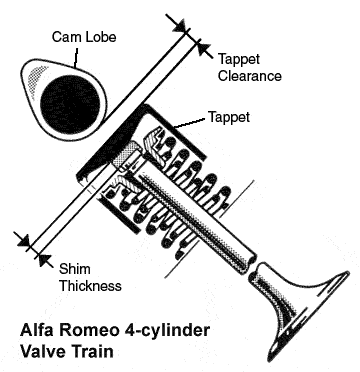A picture of a shim under bucket valvetrain similar to the one in our FJR's
The FJR is a four stroke motor: intake, compression, ignition, exhaust. Those four strokes are accomplished in two revolutions of the crank. The intake when the piston is moving down, compression when the piston comes back up - one revolution of the crank, ignition and exhaust are the second revolution. The opening and closing of the valves during this cycle is controlled by the camshaft. The intake valves are open during the intake stroke, the exhaust valves during the exhaust stroke (a bit simplified, but close enough). That means that the camshaft only has to open the intake and exhaust valves once per every two strokes of the crank.
In other words if your tach reads 4,000 RPM the cams are turning 2,000 RPMs, tach reads 8k rpms, cams are at 4k rpms. Now picture that cam lobe above turning at 2k rpms as you cruise down the highway at 75mph. That means that the tappet is riding up and then back down the lobe of the cam in the picture roughly 33 times a second! Engineers spend a great deal of time getting the profile of that lobe correct so that at the velocities we are talking about the valve is not slamming into that ramp (or the valve seat on the other side), but rather riding on it nice and smoothly. The tappet sits on top of the valve we are trying to open and close to spread the forces out along the cam lobe.
Well sort of, you see the tappet does not actually ride on the lobe of the cam. The tappet actually rides on a thin film of oil, not directly on the cam - metal to metal at those speeds = BAD! How thin a film of oil you ask? See the shim under the tappet? The shim is between the tappet and the valve and is used to control the valve clearance, or the thickness of the oil film, or in the diagram it is called the tappet clearance, different names for the same thing. Get that tolerance too tight and the valve actually never closes. So on the ignition stroke when the valves are supposed to be closed they are open a little bit. Not only do you lose some performance, you also will burn the valve. Get the tolerance too lose and the valve will close OK, but it is so far off from the ramp that all of the hard work done by the engineer goes out the window and the tappet slams into your cam lobe 33 times per second. That is not healthy either.
Now the terminology seems backwards, why would too tight mean the valve never closes? You measure the tappet clearance with a feeler gauge of the right thickness. Too tight means you cannot get the feeler gauge in that clearance, in other words the tappet is too close to the cam at all times, the valve never closes.
Personally, I would check those clearances before the motor doesn't start well. Either of the above clearance problems, lose or tight, are expensive.






























































